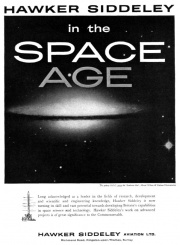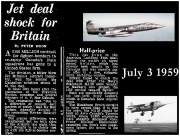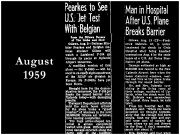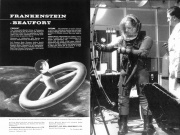The Empire Strikes Out - Canada's Defence & The Commonwealth Space Program - Part 4 by Robert Godwin
From The Space Library
Contents |
Britain to Follow Canada's Lead
Just two weeks after the announcement of the joint US/Canadian satellite venture, and ignoring the recommendations of the team at Hatfield, the British government decided to hedge their bets. Before they would consider an all-British space program they would test British experiments using rented space on American Atlas and Thor missiles; in essence following Canada's lead.[1]
About a month later, on June 13th 1959, the United States Congress began talking about cutbacks to the Bomarc missile program. Just two days after that James Floyd, the genius engineer who had built the first civilian jet airliner in North America and whose career had spanned everything from the legendary Lancaster bomber, to the CF-100 fighter, to the Avro Arrow, decided to return to England. Where he took up the role of Chief Engineer at the Hawker Siddeley Advanced Projects Office.
Under some pressure, two weeks later on June 29th the British Prime Minister Harold MacMillan formally announced the desire of his government to pursue an all Commonwealth Space Program. The pundits assumed that Canada would, and should, play a major role.[2]
Rearming the RCAF
Meanwhile, Crawford Gordon, the tempestuous head of A.V. Roe Canada had resigned. His relationship with Diefenbaker was known to be somewhat less than cordial so his departure was expected to clear the way for a new start at the troubled company; particularly since the government in Ottawa was still faced with the same unresolved problem that it had faced almost a decade earlier - what to do with Canada's Air Force. The CF-100 and the F-86 Sabres on-station were obsolete and no match for the latest generation of Soviet fighters. Several choices were considered by the cabinet: buy the new Mirage from France; purchase an experimental aircraft from Lockheed; or allow A.V. Roe to build its parent company's own brand-new experimental Hawker 1127. On July 3rd the interested parties were told that the government had chosen the Lockheed deal despite not having conducted a single test flight of the aircraft.
The parliamentary opposition accused the government of buying an untested aircraft which didn't meet Canada's requirements. The highly modified Lockheed F-104G fighter,customised to be all things to all services,would never live up to any reasonable expectations. It became known as the Widowmaker, killing pilots at an alarming pace over the next four years; with an accident rate over seven times the average across the service.[3] [4]
The Lockheed Starfighter (its real name) was also almost useless for patrolling the vast expanse of Canada's north. It was fast but it didn't have the range or the armaments for the job. The reason cited for the purchase of this particular aircraft was to fulfill Canada's obligation to NATO and to protect the very same European countries that had regularly been buying Avro aircraft to defend themselves. The last batch of CF-100s had only arrived in Belgium two years earlier.[5]
The NATO issue had been discussed in secret cabinet meetings back in February but was dismissed at the time as not being relevant since the government hadn’t yet committed to rearming the Canadian Air Division in Europe; a task which was known would cost at least $500M and would do nothing for defending the "homeland." The two proposed Bomarc squadrons would cost Canada between $20M and $120M (no one seemed to have a solid figure) but would only barely protect parts of Ontario and Quebec and would be subject to American control because they would be equipped with nuclear warheads. Around the time of the cancellation of the Arrow, Avro had quoted that the full complement of 137 Arrows would cost about $375M, considerably less than the price being told by the government to the Canadian media, in part because the government was including all of the money already spent on development.[6] It was later asserted that the Arrow couldn't have operated in NATO because it was specifically integrated into the NORAD SAGE automated radar control system. However, unlike BOMARC, the Arrow was fully capable of operating independently of the SAGE system, a fact that Avro told the government repeatedly, and despite the F-104 being completely incapable of using SAGE, two dozen F-104Gs were purchased for use in Canada in complete contradiction of this assertion.[7] The fact that SAGE was introduced when the Arrow program had been underway for three years was another fact pointedly ignored.
On August 13th, a month after the decision to buy the F-104G, Lockheed finally demonstrated the aircraft Pearkes had purchased. A standard version of the plane was brought to Ottawa to be put through its paces. In a moment of almost perverse irony the pilot went supersonic at low level blasting out windows at the brand new Ottawa airport terminal, producing $100,000 damage. The shock wave even sent some local residents to hospital with concussion.[8]
Five days later, under license from Lockheed, the government gave the new fighter contract to Canadair. The line of reasoning being that since Canadair didn’t do any work for its parent company it was, in all but title, a Canadian company. Assuming that this was a reasonable argument for having left A.V. Roe out in the cold, it didn’t make allowances for the fact that Canadair already had a robust stack of orders on its plate, including the Bomarc and the Black Brant, and didn't have the tooling necessary for the job.[9] Canadair would have to purchase new equipment; similar to the world-class machinery that was now lying fallow at Avro.
Part of the reason the Mirage deal had been rejected was because it was known that France wanted to equip the aircraft with the Iroquois engine, this would have by implication meant that part of the contract would go to Avro, but the Iroquois had already been destroyed, so this option was politically suicidal.[10] Instead the government allowed Avro to build an inferior General Electric engine for the F-104s, effectively saving a quarter of the jobs recently lost.
The Commonwealth Space Symposium
While the future of Canada’s aerospace industry was being completely rewritten the pre-arranged Commonwealth Space Symposium finally took place in London on August 27th. Phil Lapp and Arthur Maine hurriedly put together a paper which was right up to date, including the news about the Canadair contract. The pair apologized for what they perceived was a hurried summary of Canada’s aerospace capabilities. They were not able to attend the conference in person, but despite their trepidation their paper, entitled Canadian Facilities, was a brilliant overview and included a mass of statistics from every possible part of the Canadian economy that might be impacted by a space program. They noted that the aircraft industry comprised 39,000 employees and 7.7M square feet of floor space. This was after the 12,500 layoffs at Avro and the loss of 1.7M square feet now under-utilised at that moment. When discussing the electronics industry Lapp noted, "most contributions to the electronic arts arising in Canada have some link with the geography or conditions peculiar to the country."
He then clearly described Canada’s space future, "In terms of astronautical applications, the industry is well suited to contribute in practically any electronic area with perhaps special ability in communications, tracking, and data handling and processing." He also paid special attention to Canada’s chemical industry which made it perfectly suited to supply propellants derived from its rich resource-base and concocted by its chemical engineers.
At this time many in the astronautics field were actively advocating nuclear propulsion as the best method to open up space travel. Lapp and Maine pointed out that Canada was already a world-leader in advanced nuclear reactors.
At CARDE Lapp’s friend Gerald Bull was also leading the world when it came to building guns capable of accelerating payloads to speeds comparable to a re-entering ICBM. The paper went on to point out that The Defence Research Medical Laboratories, located in Downsview Ontario, were conducting medical experiments involving motion sickness, decompression and cold, and acceleration in a centrifuge. Similar work was underway at A.V. Roe in England, whose Frankenstein subsidiary was leading the development of British space suits.
Canadian universities had over 6000 students enrolled from Commonwealth countries as well as over 400 Canadians attending British institutions. Lapp and Maine also concluded that Canada was uniquely located for a high latitude launch complex for a variety of reasons including the low intensity of the Van Allen radiation belts. This observation drew attention from the delegates because of its eminent practicality, but it stood little chance of being seriously considered because the Woomera launch facility was well under way and the Australian High Commissioner, Sir Eric Harrison, had been there personally to open the conference and to make sure that Australia's interests were front and centre.
Finally, neither Lapp nor Maine had any delusions about Canada being able to go-it-alone.
"Since the British Commonwealth already exists as a freely co-operating group of countries with common interests and traditions, one might suppose that a reasonable measure of success should attend a Commonwealth space program venture. If it could be shown that this would not be the case then the outlook is indeed bleak for the completely international co-operation in space research so keenly sought by IAF and the COSPAR agency of the United Nations. It seems to be imperative that the nations of the world come to a common agreement on the conquest of space, and surely the Commonwealth has a part to play in bringing this about."
The report is so well handled it seems that Phil Lapp had found a new role. Not only did he go on to co-author the so-called Chapman Report in 1967 but he would spend the rest of his life consulting and writing hundreds of complex reports for every branch of the aerospace and resources industries in Canada. If you wanted to know what Canada could do, you asked Phil Lapp.
The British Interplanetary Society had done a superb job of bringing together the various interested parties. Representatives from fourteen foreign nations attended, including two from the Soviet embassy, one from the US Strategic Air Command and four from Israel's ministry of defence. Delegates from India unable to attend had also submitted papers for inclusion. On the second day De Havilland's Geoffrey Pardoe delivered a detailed explanation of the capabilities of Blue Streak leading many delegates to believe that a Commonwealth program was inevitable since the Blue Streak, outfitted with a Black Knight second stage, could outlift most of the US boosters, with the notable exception of Atlas-Agena-Centaur. Leslie R. Shepherd concluded the proceedings by saying that the BIS intended to host another summit in the future.
Go to Chapter
Footnotes
- ^ Daily Express May 4 1959
- ^ Toronto Star Jun 29 1959
- ^ Globe and Mail Oct 3 1963
- ^ Toronto Star Aug 21 1976
- ^ Aircraft Sep 1957
- ^ Canadian Aviation & The Avro Arrow - Fred Smye - Createspace 2014
- ^ Minutes of Cabinet Defence Committee Feb 10th 1959
- ^ Globe and Mail Aug 14 1959
- ^ Flight magazine Aug 28 1959
- ^ Toronto Star May 21 1959




